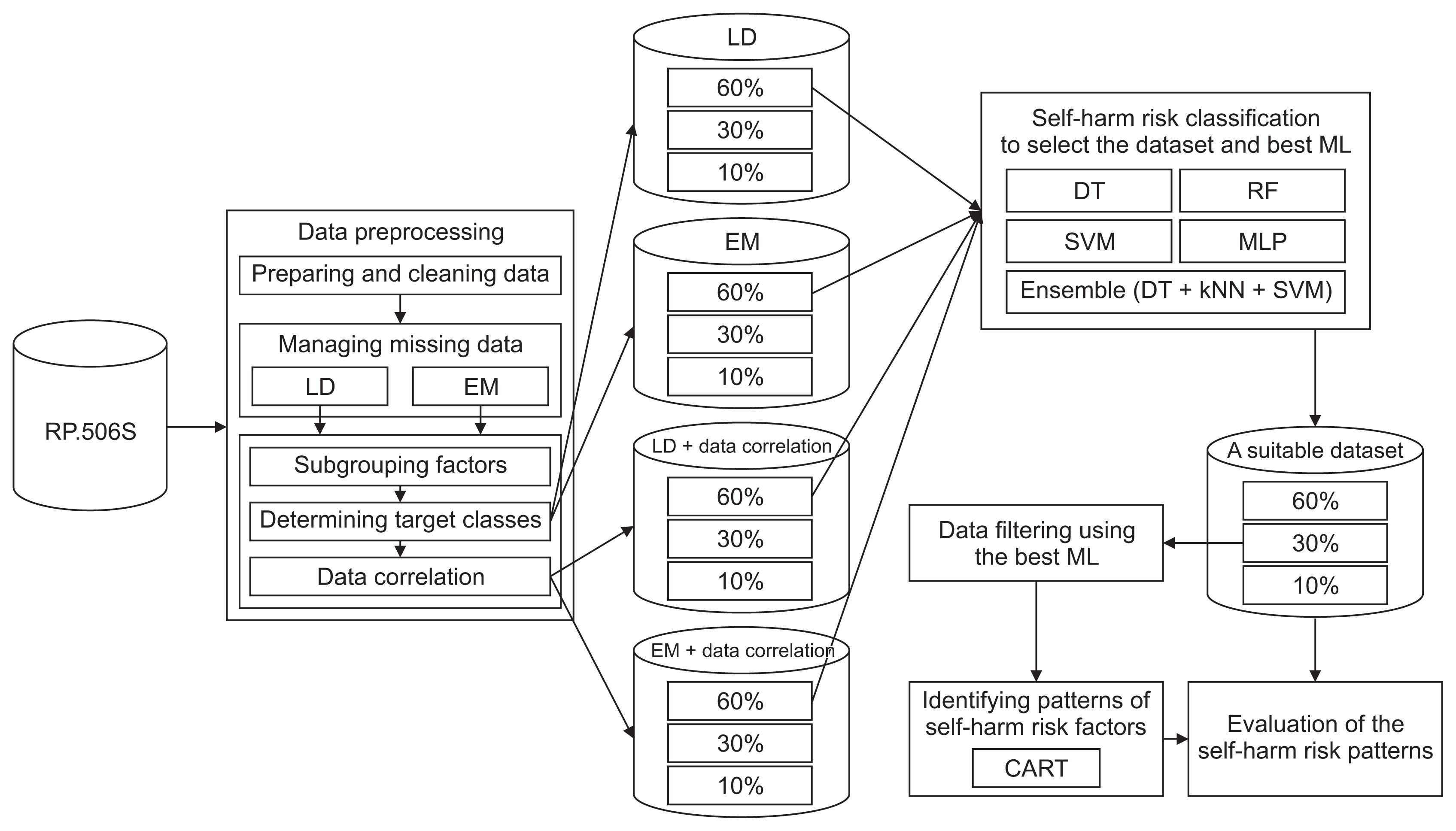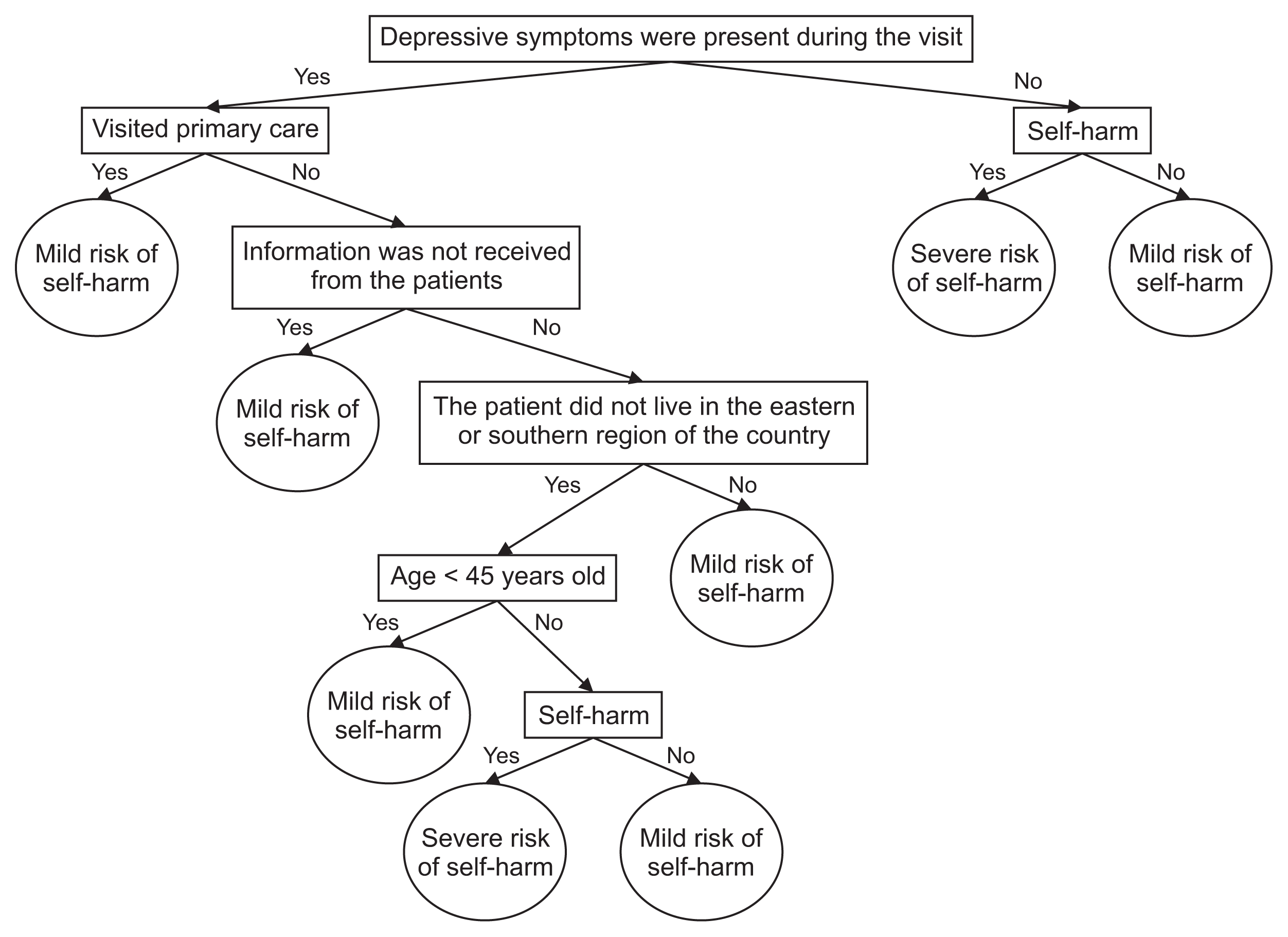4. Mansourian M, Khademi S, Marateb HR. A comprehensive review of computer-aided diagnosis of major mental and neurological disorders and suicide: a biostatistical perspective on data mining. Diagnostics (Basel). 2021; 11(3):393.
https://doi.org/10.3390/diagnostics11030393
.
6. Tougui I, Jilbab A, Mhamdi JE. Impact of the choice of cross-validation techniques on the results of machine learning-based diagnostic applications. Healthc Inform Res. 2021; 27(3):189–99.
https://doi.org/10.4258/hir.2021.27.3.189
.
7. Boonkwang K, Kasemvilas S, Kaewhao S, Youdkang O. A comparison of data mining techniques for suicide attempt characteristics mapping and prediction. In : Proceedings of 2018 International Seminar on Application for Technology of Information and Communication; 2018 Sep 21–22; Semarang, Indonesia. p. 488–93.
https://doi.org/10.1109/ISEMANTIC.2018.8549835
.
8. Zalar B, Kores Plesnicar B, Zalar I, Mertik M. Suicide and suicide attempt descriptors by multimethod approach. Psychiatr Danub. 2018; 30(3):317–22.
https://doi.org/10.24869/psyd.2018.317
.
9. Edgcomb JB, Thiruvalluru R, Pathak J, Brooks JO. Machine learning to differentiate risk of suicide attempt and self-harm after general medical hospitalization of women with mental illness. Med Care. 2021; 59:S58–S64.
https://doi.org/10.1097/mlr.0000000000001467
.
15. Wang Y, Sun K, Liu Z, Chen G, Jia Y, Zhong S, et al. Classification of unmedicated bipolar disorder using whole-brain functional activity and connectivity: a radiomics analysis. Cereb Cortex. 2020; 30(3):1117–28.
https://doi.org/10.1093/cercor/bhz152
.
16. Achalia R, Sinha A, Jacob A, Achalia G, Kaginalkar V, Venkatasubramanian G, et al. A proof of concept machine learning analysis using multimodal neuroimaging and neurocognitive measures as predictive biomarker in bipolar disorder. Asian J Psychiatr. 2020; 50:101984.
https://doi.org/10.1016/j.ajp.2020.101984
.
17. Santos-Mayo L, San-Jose-Revuelta LM, Arribas JI. A computer-aided diagnosis system with EEG based on the P3b wave during an auditory odd-ball task in schizophrenia. IEEE Trans Biomed Eng. 2017; 64(2):395–407.
https://doi.org/10.1109/tbme.2016.2558824
.
18. Lin GM, Nagamine M, Yang SN, Tai YM, Lin C, Sato H. Machine learning based suicide ideation prediction for military personnel. IEEE J Biomed Health Inform. 2020; 24(7):1907–16.
https://doi.org/10.1109/jbhi.2020.2988393
.
19. Choi SB, Lee W, Yoon JH, Won JU, Kim DW. Ten-year prediction of suicide death using Cox regression and machine learning in a nationwide retrospective cohort study in South Korea. J Affect Disord. 2018; 231:8–14.
https://doi.org/10.1016/j.jad.2018.01.019
.
20. Zheng L, Wang O, Hao S, Ye C, Liu M, Xia M, et al. Development of an early-warning system for high-risk patients for suicide attempt using deep learning and electronic health records. Transl Psychiatry. 2020; 10(1):72.
https://doi.org/10.1038/s41398-020-0684-2
.
21. Bin-Hezam R, Ward TE. A machine learning approach towards detecting dementia based on its modifiable risk factors. Int J Adv Comput Sci Appl. 2019; 10(8):1–9.
22. Chen Q, Zhang-James Y, Barnett EJ, Lichtenstein P, Jokinen J, D’Onofrio BM, et al. Predicting suicide attempt or suicide death following a visit to psychiatric specialty care: a machine learning study using Swedish national registry data. PLoS Med. 2020; 17(11):e1003416.
https://doi.org/10.1371/journal.pmed.1003416
.
23. Miche M, Studerus E, Meyer AH, Gloster AT, Beesdo-Baum K, Wittchen HU, et al. Prospective prediction of suicide attempts in community adolescents and young adults, using regression methods and machine learning. J Affect Disord. 2020; 265:570–8.
https://doi.org/10.1016/j.jad.2019.11.093
.

24. Shen Y, Zhang W, Chan BS, Zhang Y, Meng F, Kennon EA, et al. Detecting risk of suicide attempts among Chinese medical college students using a machine learning algorithm. J Affect Disord. 2020; 273:18–23.
https://doi.org/10.1016/j.jad.2020.04.057
.

25. Alimardani F, Cho JH, Boostani R, Hwang HJ. Classification of bipolar disorder and schizophrenia using steady-state visual evoked potential based features. IEEE Access. 2018; 6:40379–88.
https://doi.org/10.1109/ACCESS.2018.2854555
.

26. Çolakoglu N, Akkaya B. Comparison of multi-class classification algorithms on early diagnosis of heart diseases. In : Proceedings of tge y-BIS Conference 2019: Recent Advances in Data Science and Business Analytics; 2019 Sep 25–28; Istanbul, Turkey. p. 162–71.
28. Onishi K. Risk factors and social background associated with suicide in Japan: a review. Jpn Hosp. 2015; (34):35–50.




 PDF
PDF Citation
Citation Print
Print





 XML Download
XML Download